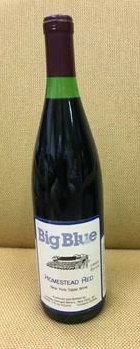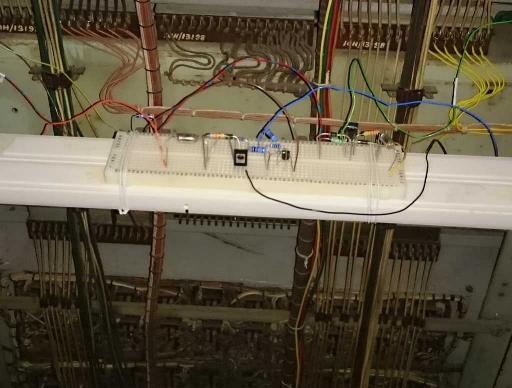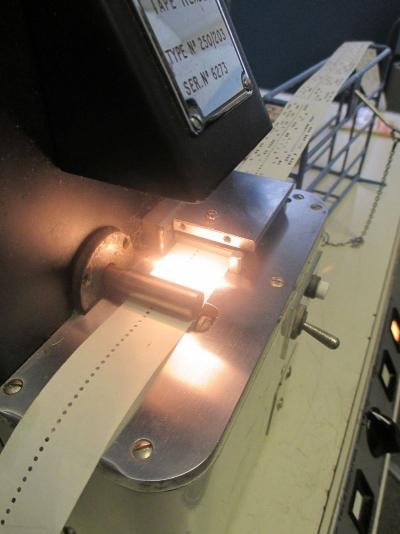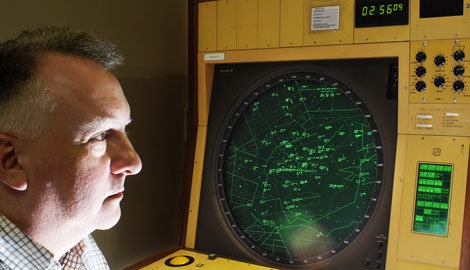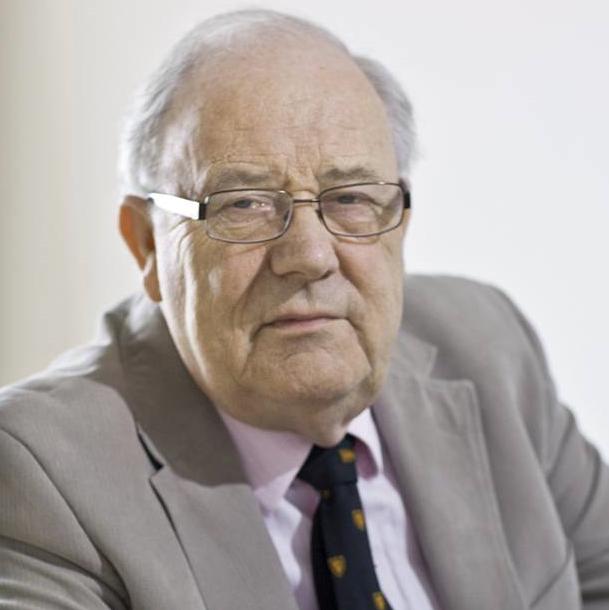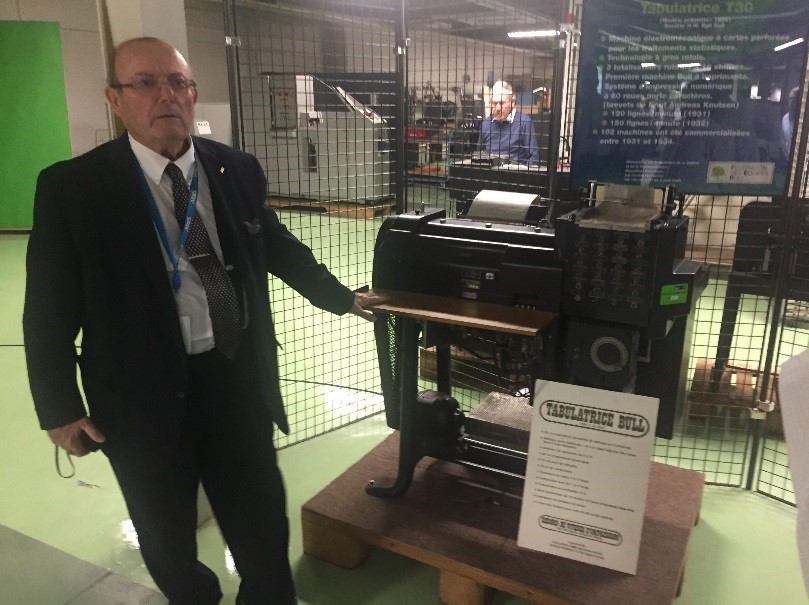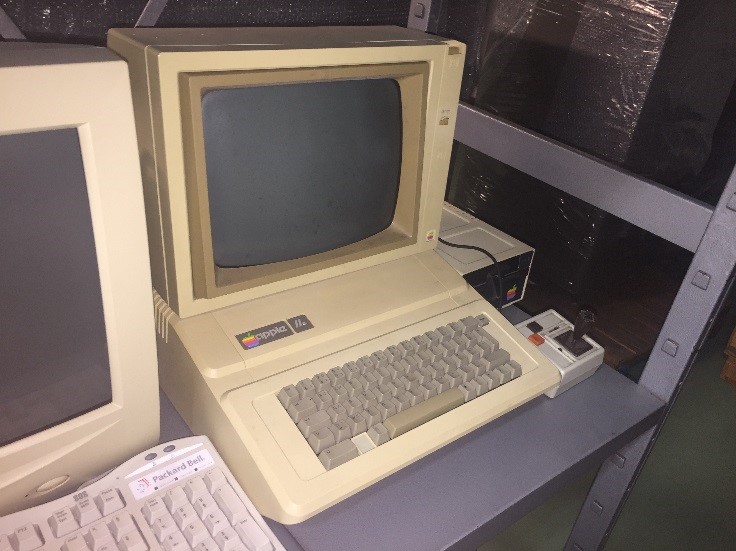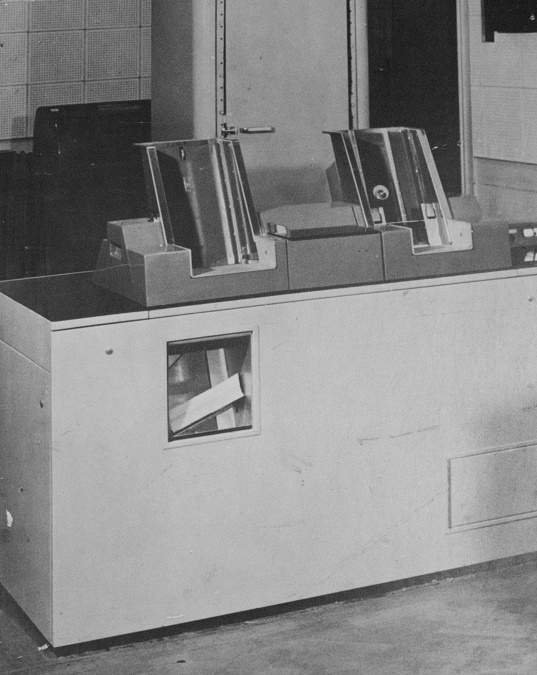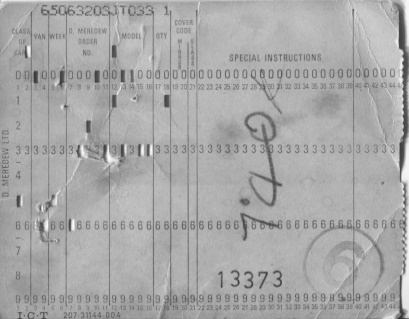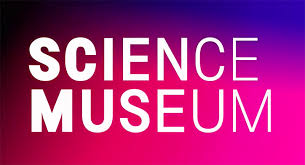| Resurrection Home | Previous issue | Next issue | View Original Cover | PDF Version |
Computer
RESURRECTION
The Journal of the Computer Conservation Society
ISSN 0958-7403
|
Number 83 |
Autumn 2018 |
Contents
| Society Activity | |
| News Round-up | |
| Chair’s Report | David Morriss |
| The Computer-Aided Design Centre at 50 | Alan R. Clarke |
| Installing an ICL 1907F at RRE Malvern | Michael J. Clarke |
| Bull Technology Museum | Mike Smith |
| A Life in Computing | Mike Brisk |
| A Mystery Picture | Dik Leatherdale |
| 50 Years Ago .... From the Pages of Computer Weekly | Brian Aldous |
| Forthcoming Events | |
| Committee of the Society | |
| Aims and Objectives |
Society Activity
|
EDSAC Replica — Andrew Herbert The EDSAC team continues to be focussed on commissioning. Having convinced ourselves that the pioneers adopted a bistable design for flip-flops earlier than that which we originally thought, we have been replacing monostables with bistables in key areas to achieve more reliable operation and this is beginning to show results. The bistables require a -50V DC supply which has led to some revision of the power supply arrangements. In recent weeks the machine has run short sequences of X (no-op) orders, demonstrating orders being fetched from store, decoded, dispatched to the arithmetic unit, executed and a concluding “End Pulse” returned to step on to the next order. Our immediate objective is to reach a state where the machine can reliably execute long sequences over a period of several minutes. Progress has been helped by the development of a custom laptop-based logic analyser to monitor waveforms as logic levels and signals. This is just been extended to 16 channels so that we can track main control, store and coincidence systems simultaneously. There has also been further work on testing long nickel delay lines as main store. This has shown up some sensitivities that are under investigation. Our minds are increasingly focussed on the opportunity arising from 6th May 2019 being the 70th anniversary of the original EDSAC running its first programme. |
|
ICT/ICL 1900 — Delwyn Holroyd, Brian Spoor, Bill Gallagher ICL 1904S/ICT 1905 The large scale review of the code for the 1904S and 1905 emulators has now been completed and apart from a couple of minor snags to sort and the completion of the user guide we are almost ready for a release. We are hoping to announce the release at the CCS meeting on 20th September, which means that by the time you read this the emulators will be available on public release. See icl1900.co.uk for further details. GEORGE 2+ One of the tapes recovered from Bracknell was GEORGE 2+/DOF v2B, which appears to be the final release of this product, dated 1982. We have attempted to run it, unsuccessfully, so have created a new source for this version by updating a copy of the /2A source by means of binary compares, in order to investigate the problem. |
|
Bombe Rebuild — John Harper Readers may have noticed that I did not produce a report for Resurrection 82, because this was well covered by Roger Johnson’s excellent report on page 13. After the move the machine was soon working and we were again giving presentations in a matter of days. There was an official opening at TNMoC towards the end of June where we were very lucky to have with us two of the original WWII Bombe operators. Our new area is quite different around the walls, but the main machine demonstration area is much as before. Due to very limited wall space, fixed display boards are unrealistic so we have changed to multiple, large video display screens were we can readily change what is on view. We have built up a number of display ‘shorts’ lasting a few minutes each and are continuing to produce more, to add even more variety. One of these is a film of a recent demonstration and can be shown should we not be in a position at any time to provide ‘manned’ demonstrations. We can connect all this, together with video cameras and sound, to Skype but more of this in the next issue. All this was going well but then we started to have clutch problems where at the end of a run the clutch would no longer reliably bring the machine to a halt but would miss a catch and bounce around the following possibilities making a nasty noise. This was believed to be and why certain relay points arced seriously resulting major contact damage. We could not give regular demonstrations for a while and our long standing ‘uptime’ record is no longer intact. After many days of investigation and relay repair it was found that the clutch is badly worn and new parts will have to be made and replaced. I suppose this is perhaps to be expected after more than 10 years of running on most days of the week. However we did find a way of providing adequate demonstrations by slowing the main DC motor, and hence the whole machine down. This was an interesting episode involving studying DC motor electrical theory. Now to very sad news: John Borthwick died on 14th August. John was Secretary and a TWBRT Trustee. He had been working with us on the Rebuild for over 20 years. A memorial service is currently being planned and we are providing input to a eulogy but this is not ready for this report but we intend to add something substantial to the next Resurrection. |
|
Harwell Dekatron/WITCH — Delwyn Holroyd This summer has seen an unprecedented level of unreliability — and in case you were wondering the problems started before the really hot weather. The issues have mainly been related to the two trigger tubes in the accumulator, which are both of the high speed type with which we have had numerous issues in the past, but also thrown into the mix were a valve failure and several relay issues. Unfortunately all these issues overlapped and occurred within the space of a few weeks, making them exceedingly difficult to diagnose. The valve failure was notable since they occur so rarely — in this case both halves of a double triode in the translator unit were conducting when only one should have been, leading to certain characters on the program tape becoming invalid during a read into store operation. The trigger tube failures were harder to pin down as the symptom is generally erratic behaviour. As they age the tube characteristics change. Eventually it gets to the point where the trigger threshold can no longer be adjusted so that it works reliably over the working temperature range. When fitting ‘new’ trigger tubes, the characteristics change very rapidly over the course of a few days before hopefully stabilising, but sometimes they stop working altogether. This happened to several replacements we fitted over the summer, and so I decided it was time to take more radical action. I have long thought these trigger tubes would be the first type of component to require replacement with an alternative to keep the machine running in the long term. The alternatives under consideration are: a solid state equivalent circuit, and the non high-speed GTE175M trigger tube used elsewhere — the high-speed properties of the original are not thought to be required in this application. Over the course of a couple of weekends, solid state circuits were designed and prototyped on bread board. It isn‘t feasible to construct a circuit that is pin-compatible with the trigger tube — the approach taken was to take the trigger signal before tube-specific bias and conditioning and to generate an equivalent output signal.
The photo shows the circuits installed on a temporary shelf attached to the rear of the rack behind the accumulator. In one case the active elements of the circuit consist of an SCR followed by a high voltage PNP transistor, and in the other case just an SCR sufficed. No modifications were needed to the machine other than soldering a few wires on and removing the trigger tubes from their sockets. The circuits have now been in place for over a month and following a small adjustment to SCR gate current no problems have occurred in the last three weeks. The next step is to prototype a circuit using the GTE175M trigger tubes, which by contrast have so far been perfectly reliable and stable. After testing this we will make a decision which way to go long term. The choice is not straightforward: the solid state circuit can be installed with very minimal modification to the machine, but with the loss of two of the blinking lights that are so much part of its personality. The replacement trigger tube circuit would retain the visual appeal, but requires much more intrusive modification to allow installation in the existing valve bases. |
|
KDF9 Software Preservation — David Holdsworth Domain Name Problems Owing to circumstances beyond my control, the domains ending in settle.dtdns.net which all lead to my in-house server ceased to exist at the end of July 2018. The company DTDNS ceased operation. I have put in place a route to my in-house (literally) server going via sw.ccs.bcs.org I have updated pages on sw.ccs.bcs.org to reflect this change, and provided information on how to convert a dtdns.net URL into one that works now. Perhaps some of the material on this server should move to sw.ccs.bcs.org, but I am loth to move the on-line execution facilities as the implementation technique does leave the server slightly at risk. The sw.ccs.bcs.org server is in a local school where physical access is inconvenient and requires advance notice. I can reboot the machine in my study whenever I want. Both machines are Raspberry Pis but of very different vintages. Kidsgrove Algol Brian Wichmann’s test suite continues to tease out issues. Now that we accept that we do not have the final definitive version, Brian’s test suite enables us to get some measure on the quality, which is not much worse than the 1970 version. There has been some progress on the presentation of the on-line version, and significant cleaning up of its internals. KDF9 Assembly Languages We now have on-line access to both assembly languages, each of which offers two assemblers, the original and also the 21st century yacc-based version. The text of the web pages needs serious revision, but the underlying execution of the preserved software works. Algol Basic Symbols The KDF9 character set is neither a subset nor a superset of ASCII. We still have compatibility issues over representation of KDF9 characters for different languages. All but the Whetstone implementation go through an Algol Basic Symbol stage. How best to represent × and * for input is not obvious. Output is mostly rendered in HTML where we can do all the KDF9 characters. KDF9 write up Bill Findlay has set himself the task of writing up the KDF9. We met in Edinburgh recently and are collaborating very cordially. |
|
ICL 2966 — Delwyn Holroyd
Several repairs have been completed over the summer. I reported in March that the comms link from the 2966 to the 7501 was generating garbled characters, but that the 7501 was working fine when attached to the Pi so the fault must either be in the cable or the 2966... Wrong! The synchronous clock is generated by the 7501 itself, and the negative swing on this clock had almost disappeared. Having traversed the long cable to the 2966 and back, the clock was too small for reliable data reception. The link to the Pi is much shorter and the Pi actively regenerates the clock, hence no problem. The fault was cured by replacing the clock driver IC on the P004 board in the 7501. Following reconditioning of the band rollers the printer had developed another issue, complaining of band speed and sync errors. Although we had tried adjusting the band sensor already, clearly we didn’t do it correctly as a further adjustment has resolved it. One of the 7181 terminals blew a fuse and the mains input was found to be short circuit. This was traced to one of the mains filter capacitors, all of which were replaced to ward off further trouble. This unit also has a long standing intermittent 5V supply issue, the problem being that whenever I try to investigate it the fault goes away and won’t return for some months! Finally a mechanical issue - the bearings in the OCP cabinet fan had begun to make worrying noises. Changing them was not straightforward since the motor in this cabinet is larger than in the others — removing it required eight rivets to be drilled out. The fan bearings in the other cabinets all needed replacement back in 2009, so this one has lasted very well. |
|
Elliott 903 — Terry Froggatt In Resurrection 82, I reported that the TNMoC 903 had behaved perfectly at the ceremony held in May in memory of Oliver Harlow. Sadly, it has been less reliable since and at one point it was refusing to read in any binary tapes. Peter Williamson and I spent some time swapping cards around, within the 903 and with the spare cards, after which it would read tapes again (we are not sure why), but it still was not working properly (we are still not sure why). The store is connected to the CPU by eleven 37 or 50 pin D-sub connectors, which have locking clips that are difficult to undo, and more importantly, are impossible to do up without removing the whole rack from the chassis. Suspecting damp in the store connectors, we removed the rack and blew the connectors out, to no avail. But we took the opportunity to remove the locking clips so that the connectors can be checked in situ in future. The next step is probably to put some of my own good cards back into the TNMoC 903, and to monitor its behaviour over a period of time with the help of TNMoC staff, to track down which cards are causing the elusive intermittent fault(s), which could possibly be due to dry joints. Remember that this 903 has probably had more hours of use at TNMoC than any of the other surviving 903s (including my two) have ever had.
Another 250c/s Elliott paper tape reader was recently donated to TNMoC. This looked rather rustier externally than the ones we already have, but the internals proved to be in good condition, especially the insulation on the 240v motor wires. I’ve swapped the rustier body parts with cleaner parts from one of my readers which has failed motor insulation. Also, one of the two 5-lane amplifier cards was faulty, so I’ve fitted one taken from TNMoC’s stock of 110v Southwell Park readers. This reader now works and proudly bears the “Elliott” logo not the “ICL” logo. |
|
Committee Changes
Now our previous but one chair, David Hartley has decided to relinquish his position as treasurer after more than a decade’s dedicated service to the Society. Arthur Dransfield has bravely volunteered to fill the slot. The Society is completely reliant on the various committee members giving their time and dedication. Our thanks are, in no small measure, due to these retiring members. Please also welcome their various successors. |
News Round-Up
|
Birthday greetings to Frank and Ralph Land who passed their 90th in October. Identical twins (yes, I’ve made that mistake) who both worked on LEO in the very earliest days of our industry and who remain stalwarts of our good friends the LEO Society. 101010101 Erik Baigar writes to tell us about an October conference in Denver Colorado to celebrate 50 years of the well-regarded Data General Nova machine. In the event that there is an account of proceedings we will post details on the CCS website. 101010101 We note that, yet again, the Museum of Science and Industry in Manchester has undergone a change of identity and boasts a new logo. It is now called the Science and Industry Museum (SIM) and lives at www.scienceandindustrymuseum.org.uk on the web. No, nor do I. The (London) Science Museum has also adopted a new logo (see inside the front cover) somewhat more readable than before. 101010101 July saw the passing of playwright Hugh Whitemore, author of Breaking the Code, based on Andrew Hodges’ masterful biography of Alan Turing. A couple of years ago a small party of CCS members attended an amateur dramatic performance of Breaking the Code in Hampton Hill. To our delight Whitemore was in the audience and received an ovation. 101010101 It is my sad duty to report the passing of one of my personal “Heroes of Computer Science”, Professor Andrew Colin. Andrew’s long career stretched from working with Andrew Booth at Birkbeck College through London’s Institute of Computer Science and then onto the Universities of Lancaster and Strathclyde. No stranger to the pages of Resurrection, he will be greatly missed. |
CCS Annual ReportDavid Morriss
It is a pleasure to report on another successful year for the Society. We are maintaining our membership at around 1500 including a welcome number of overseas members. We must thank the BCS for hosting our London meetings at the Southampton Street location and their help with the Resurrection journal. As a Specialist Group with a grant also we do not charge a subscription. We use our own donated funds to support projects in our field but rely on the generosity of members making donations to continue to make this possible. The Resurrection publication is issued four times a year with high quality articles and news of our projects. It is free to BCS members and available for a £10 subscription to our other members. Our extensive website has been updated and is an invaluable window into our activities. The presentation programme has been well supported both in London and Manchester. We have enjoyed a wide range of topics, including Software Preservation, Emulation, Computer Films, PDP8, Analysis of Y2K, The Numerical Algorithms Group, Constructing the EDSAC Replica and the Elliott 401. It was particularly pleasing that two of our speakers were from overseas. All our London presentations are videoed and usually available online. After a significant amount of work our AV team has been equipped with a new camera which will improve the quality of the downloads. Our international links were further enhanced by a visit to the University of Pisa. At their Museum of Computing we learned about the contribution of Olivetti to both the mainframe and desktop ends of the spectrum as well as viewing their collection. None of this would be achieved without the efforts of so many volunteers, working on projects, producing the journal, making presentations and assisting in the smooth running of the organisation. I am extremely grateful to them all. The year has seen changes to the committee both centrally and in Manchester. David Hartley has served the society in many offices, latterly as Treasurer. He retires with our grateful thanks for his huge contribution to the Society. His successor is Arthur Dransfield. Kevin Murrell has stepped down as Meetings Secretary and has been succeeded by Roger Johnson. Rachel Burnett has become Roger’s successor as Secretary. In Manchester Bob Greatrell (Chair) and Alan Pickwick (Secretary) have succeeded Tom Hinchcliffe and Gordon Adshead who have retired after many years dedicated service. We are indebted to them all for the service they gave and continue to give to the Society. Finally, a big thank you to the BCS staff who assist us and all our members for supporting our events. I look forward to another successful year. |
North West Group contact details
|
||||||||||||
The Computer-Aided Design Centre at 50Alan R. Clarke
|
Contact details
Readers wishing to contact the Editor may do so by email to
Members who move house or change email address should notify Membership Secretary Dave Goodwin
(dave.goodwin@gmail.com)
of their new address or go to
Queries about all other CCS matters should be addressed to the Secretary, Rachel Burnett at rb@burnett.uk.net, or by post to 80 Broom Park, Teddington, TW11 9RR. |
Installing an ICL 1907F at RRE Malvern
Michael J. Clarke
Just a little background first about the early 1900 machines. The 1904 was derived directly from the Canadian Ferranti-Packard 6000 computer with a more or less identical CPU. The 1907 was an enhanced 1904 as it had a 48-bit floating point unit (FPU) processor attached. Not many were sold. The Gas Board at Solihull and Brunswick University (Germany) were notable successes. The next generation 1900 machines were the E/F range. A 1904E was a basic machine. Again not many were sold. The 1905F was a 1904E with a 48-bit FPU. More than 100 of these machines were sold. Then came the very few dual processor machines. I only know the 1907F machines of which there were but three. These machines were two 1905F machines connected to their memory via a Store Access Hardware Module know as a SMAC. The 1905Fs could be used independently by hardware switches configured at load time. The SMACs came with at least three 64Kword Memorex memory modules. More about the SMAC later. The first of these 1907F machines was installed at Royal Radar Establishment (RRE), Malvern. Its main purpose in life was in the development of the ALGOL(68R) compiler, an RRE product. The 1907F was commissioned in August 1968 and passed its acceptance trial the next month, with one notable omission. The Burroughs big fixed disc was a huge device, delivered on a low loader truck which suffered a road accident. Another disc unit had to be acquired from the USA. The SMAC was a grossly over-engineered system as it was designed and built to access 8 store modules and 8 processors! It had all the wiring and connectors to allow this enormous potential if only anyone had a large enough room to contain such a huge number of 1905F processors, not to mention a very large wallet. The hardware was able to accept or queue on a FIFO basis and store requests from the connected machines. The system executive program occupied most of the lowest 32K words of the main store so executive processing time was critical. The executive enhancements to support the dual processors were remarkably modest. The George III operating system tried to manage the rest of the main store by placing the buffers for peripheral accesses at the top of main store which this eased the load on the lowest block of store considerably. I designed and implemented a shortcut for executive exit, as the implemented system always searched all the running processes known to it before exiting. My shortcut avoided this when the cause for executive entry was NOT caused by a peripheral termination interrupt which altered the running state of an object program. The process that had been interrupted could be re-entered without scanning lots of process details to see if a higher priority process could be run. This shortcut did not get entered if the interrupt was from the system clock! A better explanation of this shortcut — if the current running program issued an executive extra code call, (i.e. a peripheral transfer request), then the shortcut was invoked on executive exit and an immediate return to that program was possible without having to scan through all the known potentially runnable programs. The dual processor system was a great success and throughput was better than twice that you could get from a single processor. There were various theories as to why this was the case, but none really explained the phenomenon. The replacement Burroughs fixed disc was a disaster. On delivery to the computer room it almost went through the false floor which then had to be reinforced. A second accident narrowly avoided. Warm up from cold and getting up to speed took over an hour. The poor engineers had to start work 90 minutes earlier! The sniffer unit was prone to give false reports. When they were not false reports the replacement of a damaged disc took days! Cleaning the 26 disks and checking for damage took hours and considerable strength! RRE changed to two of the large exchangeable disc systems with nine spindles which was faster and much more flexible than the Burroughs fixed disc which had failed its acceptance test. The damaged Burroughs disc platters were over four feet in diameter. There were 26 of them in a fully configured unit which weighed in at well over a ton. No wonder it almost went through the false floor! The 1907F was a remarkably stable machine and ran for over a decade before it was replaced by a second-hand 1906S! |
Bull Technology Museum
Mike Smith
Through the Computer Conservation Society we enjoy the vast history and heritage of computing technology, predominantly originating in the UK, though with interest and visits to other countries too. Having been in the industry myself working with mainframes, mini systems and all sorts of technologies over the years I recently discovered a hidden gem in Angers, France that I wanted to share with you. Some may be familiar with CAP Group (Computer Analysts and Programmers), a software house established in the UK in 1962. CAP Group merged with a French IT company to form Sema Group and over many years of market consolidation ultimately joined what is now called Atos. In 2014 Atos acquired another French IT industry veteran, Bull, itself with a rich history including names such as Honeywell, Packard Bell and Zenith Data Systems. In January 2018 I had the opportunity to visit the former Bull manufacturing plant in Angers where our current x86 server and High Performance Computing technology is assembled and tested. It was very exciting to see the latest multi-million Euro water cooled machines on test, and our “Quantum Learning Machine”, which is a 40 Qubit Quantum Computing simulator. But tucked away in the basement, there is was, a museum of Bull technology through the ages — and much of it still working.
There are a vast array other systems including some of those Honeywell, Zenith Data Systems and Packard Bell machines mentioned earlier, a variety of early laptops and PCs. In the corner I spotted a non-Bull machine, a clear example of how like-minded people across the world are brought together by a common interest. The museum will be relocated from the basement over the next couple of months and spruced up into a visitor centre for Atos customers. Angers is also a picturesque town on the edge of the Loire valley — a very nice part of the world. If there is interest from society members in visiting the museum in a future year as an organised trip I could enquire whether that could be made possible. Mike Smith is a Chief Technology Officer, Distinguished Expert and member of the Atos Scientific Community. Contact details: mike.smith@atos.net |
A life with ComputersMike BriskI am not an IT person. I have not worked in computing but with computers and their applications. Over a period of nearly 60 years I have used computers from Australia’s second digital computer to the latest microcontrollers; from large scale number crunching to real-time multi-tasking; for modelling large chemical plants, and for controlling them on-line in real time. Here is a little of my story. As I compose this on my Microsoft Surface Pro 4 laptop/tablet, I recall my first contact with computers: the SILLIAC digital computer in the University of Sydney in 1959. As a final year student in Chemical Engineering I wrote the first undergraduate Engineering thesis in Australia to use a digital computer, involving 2000-odd lines of assembler language code to simulate the dynamics of non-linear process control loops. Simulink on my Surface Pro (0.79kg, 4GB memory, 2.4GHz processor) solves these problems in seconds. The $3M — in today’s dollars — 5-ton, 2,800 vacuum tube, Sydney version of the University of Illinois Automatic Computer, using 35kW of power, with a total of 5KB of memory (1024 x 40-bit words) and 5-channel paper tape I/O took up to ten minutes, provided there were no failures (on average two tubes failed each day). SILLIAC was in the School of Physics. As a mere Engineering undergraduate I was allowed to use the machine only after hours in the evenings. However, it was a thrill to have the massive unit to myself. There were only three switches to operate it, with a paper tape bootstrap in the reader, followed by one’s program tape. You diagnosed errors by reading the 40-bit register at the bottom of the 2m high front panel, as well as the cathode ray tube Williams memory display. Perhaps the excitement from all this was enough to ensure that my professional life would eventually be dominated by working with computers in process engineering. That year I also learned to use an analogue computer for linear dynamic simulations: a 10-amplifier, 100V vacuum tube Donner model 3400. Four years later, as a junior lecturer at Sydney I taught process control using a state-of-the-art EAI TR20 transistorised analogue computer. In 1962 Sydney Chemical Engineering became the first Engineering department in Australia to have its own digital computer: an IBM 1620 with paper tape I/O. I taught FORTRAN, and later introduced the dynamic simulation package CSMP, so use of the analogue died. In the late ’60s at ICI’s Central Instrument Research Laboratory, Bozedown House, near Pangbourne, Berks., I worked with a very large SIMLAC analogue computer produced by Short Brothers and Harland, then a Ferranti Argus 400, a multi-user machine for real-time control. I used RTL, an early version of the real-time programming language RTL/2, based on Algol 68, and developed at Bozedown by John Barnes, together with DDC algorithms developed at ICI, programming the automated operation and control of a laboratory scale catalytic reactor for kinetics measurements. I used a large Algol program to model full scale reactors producing intermediates in the nylon manufacturing processes at ICI’s sites in Billingham and Wilton. These simulations were run in batch mode on a KDF9 computer with punched card input. I went back to Sydney Chemical Engineering in 1971 as a Senior Lecturer installing a DEC PDP 11-34, state-of-the-art then, with solid state integrated circuits, running under Unix, and introducing time-sharing, establishing the first student computing lab at the university to boast 12 terminals, two of which had graphics capability, a revolutionary development. In the late ’70s I used a Motorola M6800 8-bit microprocessor, coupled to some simple laboratory experiments to teach real-time programming with the concepts of interrupts and multi-tasking in a postgraduate Masters course in process control. From 1983 at ICI Australia’s large manufacturing site at Botany, Sydney, I implemented a Honeywell TDC2000 distributed control system (DCS) on the ethylene plant, coupled with a dynamic plant simulation on an Apple IIe interfaced to the TDC to assist operator training. In 1988 in ICI Australia Engineering in Melbourne I started up a new Process Control Group. A major project was the installation of an ABB MOD300 DCS on a PVC plant — a $2M investment with a very short payback. Later, as International Technology Leader, Advanced Process Control for the ICI Group, spreading the word on the benefits of process control and the value of advanced computer control through training courses in countries where ICI or its subsidiaries operated. From 1995 to 2002 as Dean of Engineering at Monash University in Melbourne, I taught undergraduate and postgraduate process control courses, and installed a MOD 300 from ABB for the Chemical Engineering Laboratory. Following retirement, I helped some major Australian mining and minerals processing companies to justify installing or upgrading of DCS facilities, and I worked with Engineers Australia on course accreditation. So now to 2012. During an accreditation visit to a university in Sydney I was shown a TR20 analogue about to be discarded after years in a corner collecting dust. Nostalgia hit hard, and I “rescued” it. For the last four years I have worked (played?) with that machine at home, interfacing it to a PC via Arduino microcomputers so the hybrid system could solve the dynamics of non-linear process control loops from my undergraduate thesis — in seconds! From SILLIAC to Arduino, from assembler language to C++ and Java, it’s been an exciting and absorbing journey. Last week I attended a talk on quantum computing. I envy what the next generation will experience. Emeritus Professor Michael Brisk is a retired chemical engineer. He spent about half his professional life in process control with ICI in the UK and Australia, becoming International Technology Leader Advanced Process Control, and half as an academic at the University of Sydney, and later at Monash University, Melbourne where he was Dean of Engineering. He can be contacted at mbrisk@bigpond.net.au. |
CCS Website InformationThe Society has its own website, which is located at www.computerconservationsociety.org. It contains news items, details of forthcoming events, and also electronic copies of all past issues of Resurrection, in both HTML and PDF formats, which can be downloaded for printing. At www.computerconservationsociety.org/software/software-index.htm, can be found emulators for historic machines together with associated software and related documents all of which may be downloaded. |
A Mystery PictureDik Leatherdale
|
50 Years ago .... From the Pages of Computer WeeklyBrian Aldous4/70 gives NDPS its first teeth: The first non-dedicated computer to be ordered by the GPO’s National Data Processing Centre is an ICL System 4/70 worth £800,000. It will be installed at the Leeds NDPS centre next March. While initially it will be used for major tasks within the Post Office the system has sufficient capacity to handle other work, possibly for outside customers. (CW103 p1) ICI to use M2140 on chemical evaluation: Data from a high-resolution mass spectrometer, used by the research department of ICI Pharmaceuticals Division, is to be processed by an English Electric M2140 computer system. The machine will work on line to the spectrometer to assist in determining the chemical structure of unknown compounds. (CW103 p1) Low cost graphics terminal designed by UK firm: A wide open market exists for a small inexpensive graphic display terminal. This is the opinion of Graphic Displays Ltd of Luton, which has designed a model to fill the gap below the sophisticated high-performance systems currently available. The company is building the prototype using an ordinary television tube. It expects the final version, including software, to sell at about £3,000. (CW103 p3) 360/65 complex for Passenger Name Record system: Following two and a half years’ development the passenger name record (PNR) reservation system has been formally initiated by Eastern Air Lines. Initially the system will be limited to the Miami area, though by May next year it will cover the entire USA. PNR will be capable of handling data relating to over a million passengers at one time, the central computer complex taking information from reservation centres at Atlanta, Charlotte, Chicago, Houston, Montreal, Woodbridge NJ, Tampa, San Juan and Seattle as well as Miami. (CW103 p9) GLC control techniques at Thamesmead lead world: A massive scheme using computer techniques to control the entire building operation for the Thamesmead communit y project on the Woolwich marshes in East London is in the final stages of implementation. The scheme is being run by the Greater London Council on their IBM 360 machines, and is said to be unmatched for size and complexity anywhere in the world. (CW103 p16) DEC cuts costs of time sharing: The use of time sharing techniques by even the smallest computer user has become a practical proposition with the introduction of Time Share-8, based on the PDP-8/I, by Digital Equipment Co. Costing between £20,000 and £50,000, the system can handle from 8 to 32 terminals simultaneously. A basic Time Share-8 system, costing £21,500 exclusive of terminals, includes a PDP-8/I computer with an 8K core store, backed by a 250,000-word disc and an extended arithmetic option. (CW104 p1) Twin 3300s in Tote’s £5m plan for betting: British punters’ bets will be processed by an American computer in 1971 when plans announced this week by the Totalisator Board come into operation. British machines were placed in second and lower places following an investigation by Tote computer officials planning a system to gain more of the off-course betting market. The success of Control Data Corporation in supplying a system to Australia, which has the nearest comparable betting system to that used here, weighed heavily in the choice and CDC have been named as suppliers of the UK system. (CW104 p1) Sadie and Susie now in one company: A new British computer company, Business Computers Ltd, has been formed by an amalgamation of Bismec Computers and Systemation. These companies have been closely associated since 1964, with Bismec handling the sales and marketing of the Sadie and Susie machines made by Systemation. (CW104 p3) GPO plans better data transmission services: The rate of growth of data transmissions in the UK is clearly shown by figures given last week by Mr John Stonehouse, the Postmaster General. Last year, he said, “We were installing 20 Datel terminals a week, this year our average is 120 a week, and next year it will be 200 or more.” The PMG was announcing improvements in the Post Office data transmission service introduced to keep up with the “explosive pace” of demand and to help meet customers special needs. (CW104 p16) Merger gives UK lead in process control: The merging of GEC/AEI-English Electric will take a British company into the world lead for the number of automation and process control computers installed. With a combined total of 451 systems, the new group will have a clear lead of 125 machines over its nearest rival, the giant General Electric of America. (CW105 p1) Biggest touchwire order for ATC triple Myriad system: A first major British order for touchwire display terminals has been awarded to Marconi by the Ministry of Technology. The 74 units are to be used in the £1.5 million flight plan processing system (FPPS), based on a triple Marconi Myriad complex, at the new Southern Area Air Traffic Control Centre, at West Drayton, Middlesex. (CW105 p16) ICL joins RCA in mag tape company: The formation of a joint company by ICL and RCA to make magnetic products marks another move in the swing towards the use of magnetic tape as the prime media for computer data input and handling. The new company, to be known as RCA Magnetic Products Ltd, is owned 25 per cent by ICL and 75 per cent by RCA Great Britain, the wholly-owned subsidiary of the Radio Corporation of America. (CW107 p1) 1901 for Program Development: What is believed to be the first UK computer to be installed by a consultancy exclusively for program development is now in operation for Hoskyns Systems Management at their Hatton Garden offices. The machine, a 16K 1901, is being used by a team of 30 programmers working on programs for clients in manufacturing industries. The programs fall into two categories. The first group covers modular systems for the application of lower cost production and stock control, and the second group is designed to improve the operational efficiency of clients’ machines. (CW107 p1) Deflection Technique for Graphic Displays: A digital deflection technique developed by Univac for graphic display systems is claimed to improve the resolution, speed and accuracy of the display over anything at present available. Univac also claims the quality of the display to be high enough for use in the design of integrated circuits. (CW108 p1) Research ship Discovery to have 1800: An oceanographic research ship, the Royal Research Ship Discovery, is to have an IBM 1800 computer system installed as part of a re-fit now being carried out at Aberdeen. The computer will be used for data logging and conventional batch processing of information collected at sea on trips lasting up to three months. (CW109 p3) Multi-access graphics for ICI designers: The provision of multi-access graphic display facilities for every design team in the company’s divisional engineering departments is the five-year target of the giant Imperial Chemical Industries. Already one of the largest computer users in the country, for the last two years ICI has been using a batch processing system for detailing pipework in the design and building of chemical plant. The system, which is used extensively by seven ICI divisions, is claimed to have saved 60% in costs of detailing pipe work, and to have improved productivity by up to 10 times. As the pipework of a plant is 25-30% of the total cost, this represents a significant saving. (CW110 p1) OCR reading techniques at Interbank: Encouragement for smaller users of clearing banks is to be provided by the introduction of OCR reading techniques at the Interbank Computer Bureau. The system will use a Retina reader, valued at £407,000, ordered from Recognition Equipment Co, of Maidenhead. Users will be able to submit lists and schedules in machine readable font to the centre where they will be transferred to magnetic tape for use on the tape-based clearing system operated at the centre. (CW112 p1) First Major Schools System — Hatfield project approved: Approval for the first major project in the UK to take computing into the schools has been won from the Department of Education and Science and it is planned to set up a £300,000 system at Hatfield College of Technology. (CW113 p1) Tactical trainer for the Royal Navy: A tactical trainer, based on a suite of three digital computers, nearing completion for the Royal Navy, is believed by both the customer and its makers to be the most advanced in the world. (CW113 p5) Motorway System Incorporates 903: The new signalling system for the West Riding Motorway will incorporate an Elliott 903 computer. Main contractors on the £200,000 project will be GEC Road Signals Ltd. The system will be basically similar to that used on the M4 Metropolitan Motorway. The system will use 90 illuminated signs operated by remote control from Wakefield Police centre. The signs consist of a one metre square matrix of low voltage bulbs. Different combinations are used to indicate direction, speed limits and warnings of lane closures. (CW114 p2) Graphic Display System — E-A launch satellite: A satellite graphic display station that only needs access to a large processor for computation has been introduced by Elliott Automation. Known as the 928 system, it is the first British graphic display equipment of this kind. The interactive display has its own computer, an Elliott 905, so that all data and symbolic manipulation is carried out within the satellite system. (CW115 p1) |
Forthcoming EventsLondon Seminar Programme
London meetings take place at the BCS in Southampton Street, Covent Garden starting at 14:30. Southampton Street is immediately south of (downhill from) Covent Garden market. The door can be found under an ornate Victorian clock. You are strongly advised to use the BCS event booking service to reserve a place at CCS London seminars. Web links can be found at www.computerconservationsociety.org/lecture.htm. For queries about London meetings please contact Roger Johnson at r.johnson@bcs.org.uk. Manchester Seminar Programme
North West Group meetings take place take place at Manchester Metropolitan University: 17:00 for 17:30. For queries about Manchester meetings please contact Alan Pickwick at alan_c_pickwick@btinternet.com Details are subject to change. Members wishing to attend any meeting are advised to check the events page on the Society website at www.computerconservationsociety.org/lecture.htm. MuseumsSIM : Demonstrations of the replica Small-Scale Experimental Machine at the Science and Industry Musuem in Manchester are run every Tuesday, Wednesday, Thursday and Sunday between 12:00 and 14:00. Admission is free. See www.scienceandindustrymuseum.org.uk for more details. Bletchley Park : daily. Exhibition of wartime code-breaking equipment and procedures, plus tours of the wartime buildings. Go to www.bletchleypark.org.uk to check details of times, admission charges and special events. The National Museum of Computing Colossus Galleries open daily 10.30-17.00; full Museum open Thursday, Saturday and Sunday 12.00-17.00; Provisional opening for the Turing-Welchman Bombe is likely to be as per the main museum. Situated on the Bletchley Park campus, TNMoC covers the development of computing from the “rebuilt” Turing Bombe and Colossus codebreaking machines via the Harwell Dekatron (the world’s oldest working computer) to the present day. From ICL mainframes to hand-held computers. Please note that TNMoC is independent of Bletchley Park Trust and there is a separate admission charge. Visitors do not need to visit Bletchley Park Trust to visit TNMoC. See www.tnmoc.org for more details. Science Museum : There is an excellent display of computing and mathematics machines on the second floor. The Information Age gallery explores “Six Networks which Changed the World” and includes a CDC 6600 computer and its Russian equivalent, the BESM-6 as well as Pilot ACE, arguably the world’s third oldest surviving computer. The new Mathematics Gallery has the Elliott 401 and the Julius Totalisator, both of which were the subject of CCS projects in years past, and much else besides. Other galleries include displays of ICT card-sorters and Cray supercomputers. Admission is free. See www.sciencemuseum.org.uk for more details. Other Museums : At www.computerconservationsociety.org/museums.htm can be found brief descriptions of various UK computing museums which may be of interest to members. |
Committee of the Society
|
Computer Conservation SocietyAims and objectivesThe Computer Conservation Society (CCS) is a co-operative venture between BCS, The Chartered Institute for IT; the Science Museum of London; and the Museum of Science and Industry (MSI) in Manchester. The CCS was constituted in September 1989 as a Specialist Group of the British Computer Society (BCS). It thus is covered by the Royal Charter and charitable status of BCS. The aims of the CCS are to
Membership is open to anyone interested in computer conservation and the history of computing. The CCS is funded and supported by voluntary subscriptions from members, a grant from BCS, fees from corporate membership, donations, and by the free use of the facilities of our founding museums. Some charges may be made for publications and attendance at seminars and conferences. There are a number of active Projects on specific computer restorations and early computer technologies and software. Younger people are especially encouraged to take part in order to achieve skills transfer. The CCS also enjoys a close relationship with the National Museum of Computing.
|
